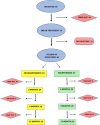Role of maintenance treatment on long-term efficacy of bilateral iTBS of the prefrontal cortex in treatment-seeking cocaine addicts: A retrospective analysis
- PMID: 36424992
- PMCID: PMC9679214
- DOI: 10.3389/fpsyt.2022.1013569
Role of maintenance treatment on long-term efficacy of bilateral iTBS of the prefrontal cortex in treatment-seeking cocaine addicts: A retrospective analysis
Abstract
CUD, like other addictions, is a chronic disease characterized by a high rate of relapse and drop-out (DO) from medical and behavioral treatment programs, which is positively correlated with relapse. Repetitive transcranial Magnetic Stimulation (rTMS) protocols have shown therapeutic potential in addiction in the short term, but only a few studies have explored their long-term efficacy, so far. This study explores the long-term outcome of bilateral intermittent theta-burst stimulation (iTBS) of the prefrontal cortex (PFC) in cocaine use disorder (CUD) and the possible influence of maintenance treatment in improving abstinence and decreasing DO rates. Eighty-nine treatment-seeking CUD patients were exposed to 20 sessions of iTBS. At the end of the treatment 61 (81%) abstinent patients underwent a 12 months follow-up. Among these, 27 patients chose to follow a maintenance treatment (M), whereas 34 patients chose not to adhere to a maintenance treatment (NM). Overall, among patients reaching the 12 months follow-up endpoint, 69.7% were still abstinent and 30.3% relapsed. In NM-patients the DO rate was significantly higher than in M-ones (58.82 vs. 29.63%). The present observations show the long-term therapeutic effect of bilateral PFC iTBS to decrease cocaine consumption. Moreover, they underline the importance to perform a maintenance protocol to consolidate abstinence and decrease DO rates over time.
Keywords: addiction; cocaine use disorder; drop out; follow up; intermittent theta burst stimulation (iTBS); repetitive Transcranial Magnetic Stimulation (rTMS).
Copyright © 2022 Sanna, Bini, Badas, Corona, Sanna, Marcasciano, De Vivo and Diana.
Conflict of interest statement
The authors declare that the research was conducted in the absence of any commercial or financial relationships that could be construed as a potential conflict of interest.
Figures
Similar articles
-
Intermittent Theta Burst Stimulation of the Prefrontal Cortex in Cocaine Use Disorder: A Pilot Study.Front Neurosci. 2019 Jul 25;13:765. doi: 10.3389/fnins.2019.00765. eCollection 2019. Front Neurosci. 2019. PMID: 31402851 Free PMC article.
-
Efficacy of intermittent Theta Burst Stimulation (iTBS) and 10-Hz high-frequency repetitive transcranial magnetic stimulation (rTMS) in treatment-resistant unipolar depression: study protocol for a randomised controlled trial.Trials. 2017 Jan 13;18(1):17. doi: 10.1186/s13063-016-1764-8. Trials. 2017. PMID: 28086851 Free PMC article. Clinical Trial.
-
Accelerated Intermittent Theta-Burst Stimulation as a Treatment for Cocaine Use Disorder: A Proof-of-Concept Study.Front Neurosci. 2019 Oct 30;13:1147. doi: 10.3389/fnins.2019.01147. eCollection 2019. Front Neurosci. 2019. PMID: 31736689 Free PMC article.
-
The effects of theta burst stimulation (TBS) targeting the prefrontal cortex on executive functioning: A systematic review and meta-analysis.Neuropsychologia. 2018 Mar;111:344-359. doi: 10.1016/j.neuropsychologia.2018.02.004. Epub 2018 Feb 10. Neuropsychologia. 2018. PMID: 29438672
-
Repetitive Transcranial Magnetic Stimulation for People With Treatment-Resistant Depression: A Health Technology Assessment.Ont Health Technol Assess Ser. 2021 May 6;21(4):1-232. eCollection 2021. Ont Health Technol Assess Ser. 2021. PMID: 34055112 Free PMC article.
Cited by
-
Transcranial Magnetic Stimulation as a Tool to Promote Smoking Cessation and Decrease Drug and Alcohol Use.Brain Sci. 2023 Jul 14;13(7):1072. doi: 10.3390/brainsci13071072. Brain Sci. 2023. PMID: 37509004 Free PMC article. Review.
References
-
- European Monitoring Centre for Drugs and Drug Addiction . European Drug Report 2020: Trends and developments. Publications Office. https://data.europa.eu/doi/10.2810/420678 - DOI
-
- World Drug Report 2020 United Nations publication Sales No . E.20.XI.6.
LinkOut - more resources
Full Text Sources
Miscellaneous



